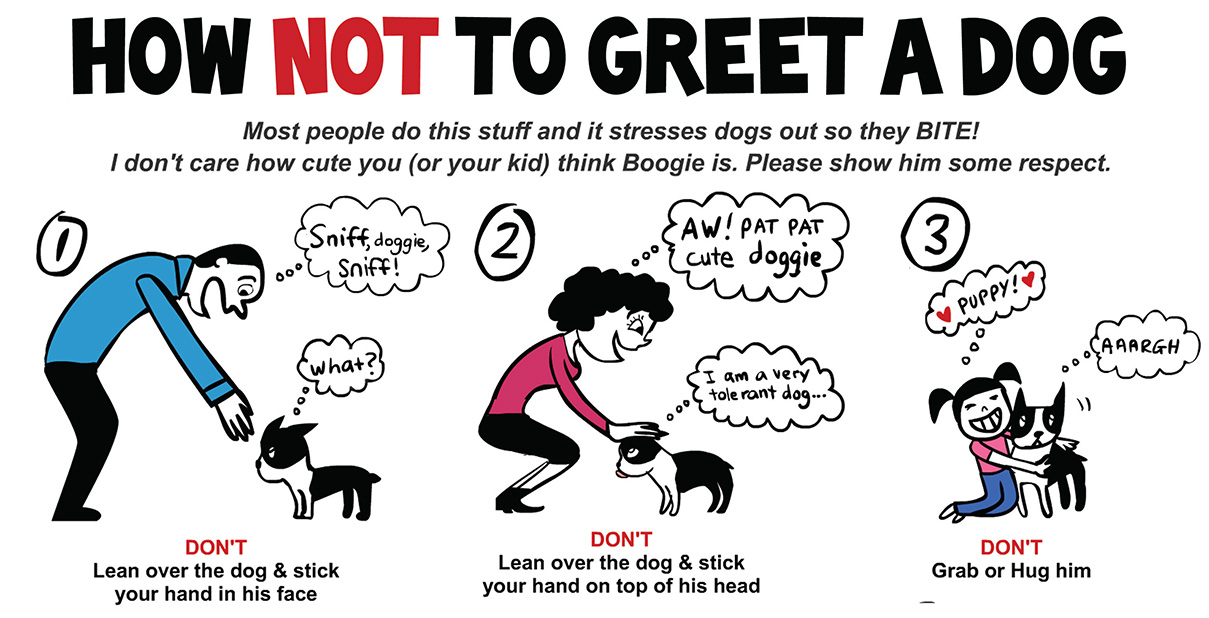NC State College of Veterinary Medicine Behaviorist Urges Awareness to Protect Children from Dog Bites

May 15-21 is Dog Bite Prevention Week!
Any dog can bite, especially when frightened or provoked. To reduce injuries from dog bites, adults and children should be educated about dog bite prevention. Dog owners should manage their dogs to avoid situations that could lead to dog bites.

Warning signs: Based on his behavior—ears down and back, “whale (white-rimmed) eye, and “worried” expression, this fearful dog may snap if a child reaches to pet or hug him.
Understanding dog body language is an important way to avoid dog bites. Often, dogs use body language and vocalizations to express that they feel anxious, afraid or threatened. Dogs may wag their tails when afraid or frightened, so a tail wag is not a reliable signal that a dog welcomes the approach of a person. When threatened, a dog may growl or bark sharply or “freeze” and give a hard stare. If approached, he may bite. When frightened, a dog may crouch and draw back, lower her ears, and avoid direct eye contact. If she can’t avoid the situation, she may bite. These signs should be considered warning signals that the dog does not want to be approached or petted.
When dogs display these signs, adults should remove dogs from situations in which an unknowing person might approach and be bitten. This strategy will also help dogs be more comfortable and less likely to bite. Children should be taught to stay away from dogs in situations in which a bite is likely:
- Children should not approach a dog when it is growling or barking.
- Children should not approach a dog when it is sleeping, eating, chewing on a bone or toy, or caring for puppies.
- Children should not reach to pet a dog behind a fence or in a parked car.
- Children should always ask permission from the dog’s owner or guardian before petting a dog. If permission is given, the child should pet the dog on its shoulder or back and not on its head.
- If a loose dog approaches, the child should be taught to turn away and “be like a tree” or, if knocked down, should curl in a ball and “be like a rock.”
Dr. Barbara Sherman, a veterinary behaviorist at NC State University, advises parents to: “Always supervise interactions between dogs and children, even those known to the parent and child and believed to be friendly. Most dog bites are from a dog known to the person. Not all dogs welcome interactions with children. Look for the behavioral signs that the dog does not welcome the approach of a child. If approached, a dog displaying the signs may bite as a way to keep the child away. Io avoid a dog bite, immediately separate the child and dog. At home, all dogs should have a safe place ‘out of reach’ of children.”
For more information:
- NC State Behavior Medicine Service
- The College of Veterinary Medicine faculty collaborated with the Wake County Department of Public Health to develop a bi-lingual coloring book to teach children of all ages how to be safe around dogs. The book may be downloaded from: http://www.wakegov.com/pets/health/safety/Documents/ColoringBookdogbiteprevention309.pdf
- The American Association of Veterinary Medicine Dog Bite Prevention Resource: https://www.avma.org/public/Pages/Dog-Bite-Prevention.aspx
- Doggone Safe Bite Prevention Tips: http://www.doggonesafe.com/dog_bite_preventio_tips
- ASPCA Dog Bite Prevention: http://www.aspca.org/pet-care/dog-care/dog-bite-prevention
- Centers for Disease Control: Preventing Dog Bites: http://www.cdc.gov/features/dog-bite-prevention/
[document id=”184801″]
- Categories:


